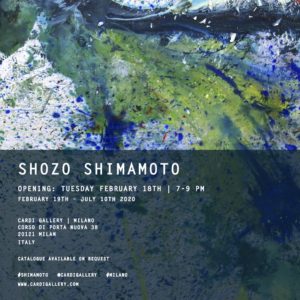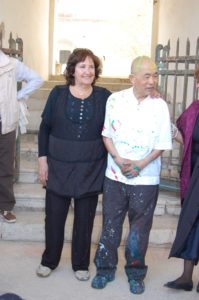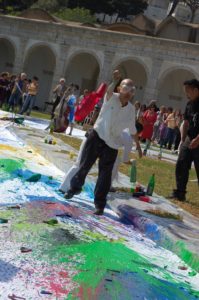CARDI GALLERY
SHOZO SHIMAMOTO
In mostra a Milano dal 19 febbraio al 10 luglio 2020
Inaugurazione: Martedì 18 febbraio, ore 19-21
Cardi Gallery Milano ha il piacere di presentare una grande mostra personale dell’artista giapponese Shozo Shimamoto (Osaka, 1928-2013).
Questa esposizione, attraverso un importante corpus di opere, mira a valorizzare la più tarda produzione dell’artista, che Rosanna Chiessi, fondatrice e presidente dell’Associazione Shozo Shimamoto fino alla sua scomparsa, ha supportato attraverso l’organizzazione di molte delle performance che hanno reso il maestro celebre in tutto il mondo.
Shozo Shimamoto è stato co-fondatore con Jiro Yoshihara del movimento Gutai (che significa concretezza). Nel 1954 il movimento prese le mosse da una serie di fermenti che in quegli anni animarono il Giappone e favorirono un processo di radicale ripensamento della tradizione artistica e pittorica in particolare. Il Gutai guarda alla tradizione occidentale, alle avanguardie europee, all’Informale, al razionalismo minimalista, e mira a superarli sperimentando nuove soluzioni linguistiche. Con il Manifesto Gutai del 1956 e Per una messa al bando del pennello, scritto dallo stesso Shimamoto nel 1957, si delineano i riferimenti (tra i quali l’action painting di Pollock) e gli intenti di questa esperienza artistica: l’arte è azione, l’atto di dipingere è autonomo rispetto al risultato che ambisce a raggiungere, l’arte si fa evento. Le performance outdoor di Shimamoto sfociano in vere e proprie installazioni ambientali, in cui l’interazione con il visitatore e con lo spazio circostante superano la dimensione contemplativa dell’opera e introducono un’esperienza attiva alla fruizione.
L’idea di Shimamoto è ricondurre il colore alla dimensione di materia, alla fisicità di elemento cromatico non più percepito come veicolo della rappresentazione. Shimamoto sceglie di utilizzare uno strumento intermediario, quasi un aiuto meccanico – come la bottiglia o il bicchiere pieno di colore che s’infrange sulla tela – che distanzi l’artista dalla materia cromatica e metta in gioco il caso per annullare la personalizzazione dell’espressione artistica. Il risultato della sua tecnica, definito bottle crash, è una vera esplosione cromatica. In particolare, nell’ultimo decennio della sua produzione, le azioni di bottle crash assumono una particolare configurazione sia per quanto riguarda il rapporto tra evento e opera, sia per la dimensione emotiva connessa all’azione. Si tratta infatti di momenti rappresentativi e spettacolari, veri e propri atti sociali, che prevedono la produzione di quadri quale loro esito. Il risultato è frutto del caso, ma il gesto e la sua spettacolarizzazione sono calibratissimi. Shimamoto, talvolta in posizione sopraelevata rispetto al “campo” di lavoro, non si limita a scagliare contro la superficie terrena i bicchieri di plastica e le bottiglie riempite di colore, ma le solleva, le mostra in una sorta di ostensione celebrativa e poi le affida alla caduta. Le performance di Shimamoto sono una manifestazione drammaturgica, spesso dai connotati di una danza. Le sue tele, come grandi e piccoli universi, racchiudono questa danza cosmica al loro interno e ne liberano l’energia davanti a chi le osserva.
Rosanna Chiessi, è stata simbolo e protagonista femminile del mondo dell’arte italiana e internazionale attraverso il suo impegno nella conoscenza e diffusione di alcune delle avanguardie più influenti del secondo Novecento (Fluxus, Arte Concettuale italiana, Azionismo Viennese e altro). Ha fondato l’Archivio Pari&Dispari e si è interessa, nell’ultimo decennio della sua vita, al movimento Gutai e in particolare all’opera di Shimamoto, con il quale ha instaurato un profondo rapporto di amicizia e collaborazione. Tra le opere esposte in galleria figurano anche alcuni dei più interessanti esiti delle performance svolte nel 2008 alla Certosa di Capri e a Punta Campanella.
Shozo Shimamoto è nato a Osaka nel 1928, dopo aver frequentato l’Università di Kwansei Gakuin è diventato celebre per avere fondato negli anni Cinquanta il movimento Gutai e si è contraddistinto per aver basato il suo stile pittorico sull’azione, dando una risposta orientale all’Espressionismo astratto di Pollock e agli Happenings di Allan Kaprow. Il suo lavoro è stato incluso in una serie d’importanti mostre, tra le quali quelle al Solomon Guggenheim Museum di New York, al MOCA di Los Angeles, al Jeu de Paume di Parigi, e trova posto nelle collezioni permanenti di importanti istituzioni internazionali quali la Tate Modern di Londra, la Galleria Nazionale d’Arte Moderna e Contemporanea di Roma e il Museo d’Arte Contemporanea di Tokyo. Nominato per il premio Nobel per la pace nel 1996, Shimamoto è morto a Osaka nel 2013 all’età di 85 anni.
CARDI GALLERY
SHOZO SHIMAMOTO
Showing in Milan from 19 February to 10 July 2020
Opening: Tuesday, 18 February, 7:00 – 9:00 pm
Cardi Gallery Milan is pleased to present a major solo exhibition by the Japanese artist Shozo Shimamoto (Osaka, 1928-2013).
This exhibition, which features a significant number of works, aims to highlight the late production of the artist, which Rosanna Chiessi, founder and president until her death of the Shozo Shimamoto Association, helped make possible through the organization of many of the performances that have made the master famous all over the world.
Shozo Shimamoto and Rosanna Chiessi, Certosa di Capri performance, 2008 (Photographs A.Mardegan)
Shozo Shimamoto was co-founder with Jiro Yoshihara of the Gutai movement (which means ‘concreteness’). In 1954 the movement grew out of a series of upheavals in Japan that sparked a process of radical rethinking of the artistic tradition, painting in particular. Gutai looked at Western culture, the European avant-garde movements, abstraction, Minimalism, and Rationalism, then attempted to move past them by experimenting with new linguistic solutions. With the Gutai Manifesto of 1956 and Banishing the Paintbrush, written by Shimamoto himself in 1957, the references (Pollock’s action painting among them) and the intentions of this artistic movement are articulated: art is action, the act of painting is autonomous with respect to the result it aims to achieve, art becomes event. Shimamoto’s outdoor performances result in true environmental installations, where interaction with the visitor and the surrounding space betrays the contemplative dimension of the work and replaces it with the active experience of the moment of viewing. Shimamoto’s idea is to bring paint back to the material dimension, to the physicality of a chromatic element no longer perceived as a representational vehicle. Shimamoto chooses to use an intermediary tool, almost a mechanical aid (the bottle or the cup full of paint that breaks on the canvas) that distances the artist from the chromatic material and puts chance into play, through which the personalization of artistic expression is erased.
The result of his technique (the ‘bottle crash’) is a true chromatic explosion. In particular, his bottle crash actions of the last decade have an unusual configuration in terms of both the relationship between event and work, and the emotional dimension connected to the action. In fact, these are representative and spectacular moments, real social acts, which include the production of paintings as their outcome. The result is generated by chance, but the gesture and its spectacularity are carefully calibrated. Sometimes assuming an elevated position with respect to the “field” of work, Shimamoto does not limit himself to tossing plastic cups and bottles filled with color against the ground, but lifts them up, displays them in a sort of celebratory ostentation, and then allows them to fall. Shimamoto’s performances are a dramaturgical manifestation, often with the connotations of a dance. His canvases, like universes large and small, enclose this cosmic dance within them and release its energy before the viewer’s gaze.
Rosanna Chiessi, symbol and protagonist of the Italian and international art world through her commitment to the knowledge and diffusion of some of the most influential avant-garde movements of the second half of the 20th century (Fluxus, Italian conceptual art, Viennese Actionism, etc.), former founder of the Archivio Pari&Dispari, became interested during the last decade of her life in the Gutai movement particularly in Shimamoto, with whom she forged a deep friendship and collaboration. Among the works exhibited in the gallery are some of the most interesting results of the performances held in 2008 at the Certosa di Capri and in Punta Campanella.
Shozo Shimamoto was born in Osaka in 1928. After attending the University of Kwansei Gakuin, he became famous as the founder of the Gutai movement in the 1950s, distinguishing himself with an action-based pictorial style, offering an Oriental response to Pollock’s Abstract Expressionism and Allan Kaprow’s Happenings. His work has appeared in many important exhibitions, including those at the Solomon Guggenheim Museum in New York, the MOCA in Los Angeles, and the Jeu de Paume in Paris, and can be found in the permanent collections of major international institutions such as the Tate Modern in London, the National Gallery of Modern and Contemporary Art in Rome and the Museum of Contemporary Art in Tokyo. Nominated for the Nobel Peace Prize in 1996, Shimamoto died in Osaka in 2013 at the age of 85.
—
Cardi Gallery | Milano, Corso di Porta Nuova 38, 20121 Milano Italy, (+39) 2.45478189, mail@cardigallery.com, www.cardigallery.com,
INFO:
Dal 19 febbraio al 10 luglio 2020
Inaugurazione: martedì 18 febbraio dalle 19.00 alle 21.00
Orari:
da lunedì a venerdì dalle 10.00 alle 19.00
sabato dalle 11.00 alle 18.00



